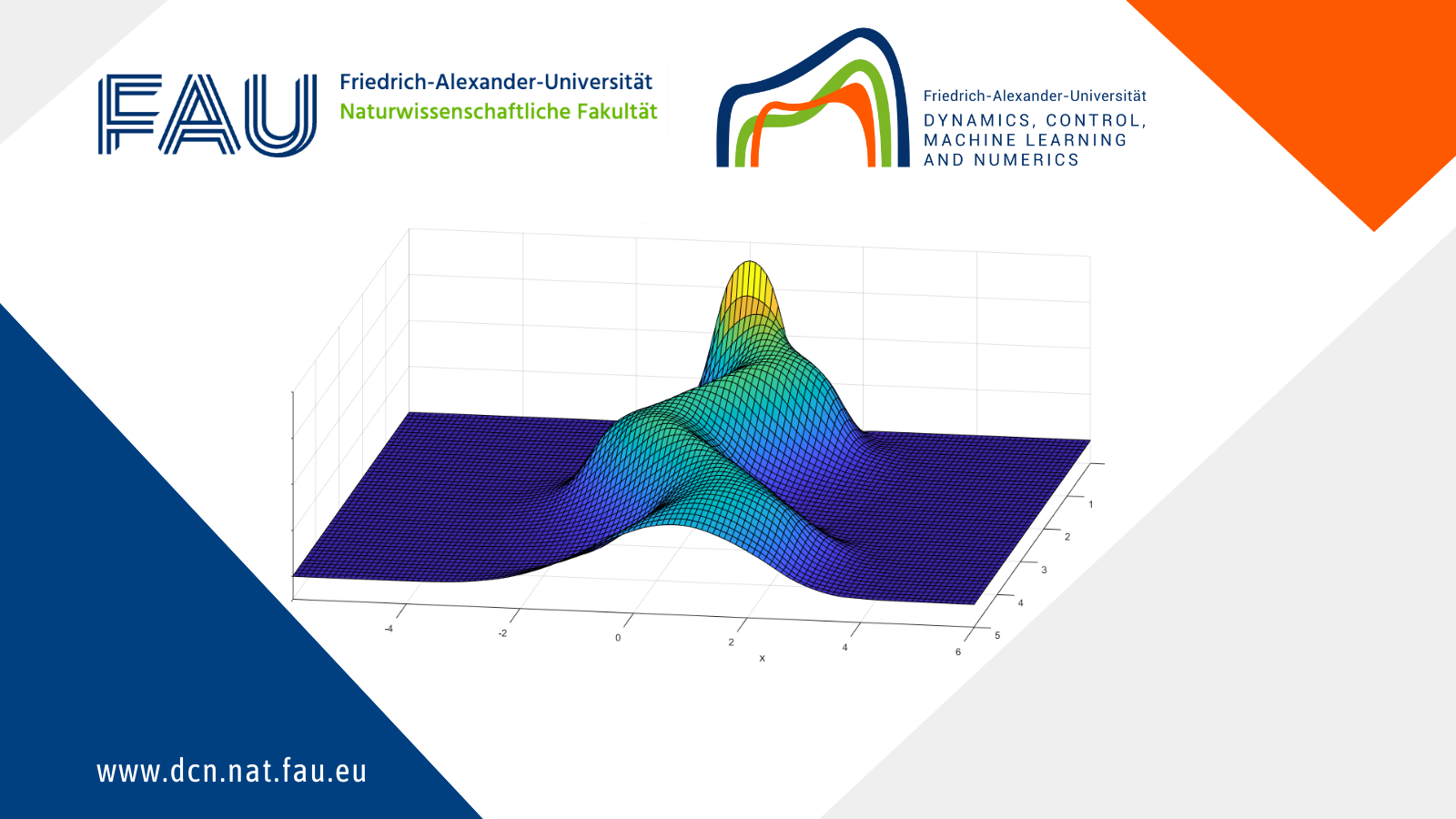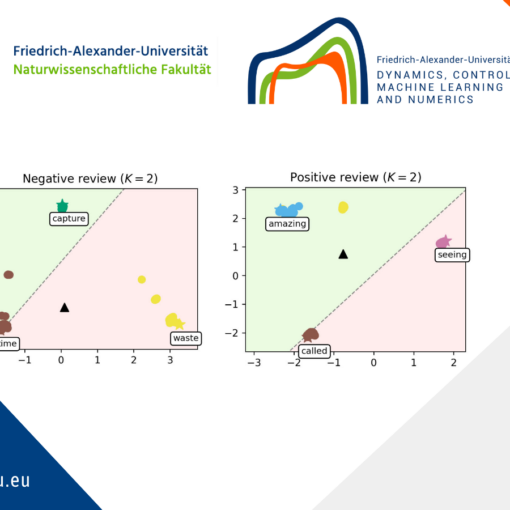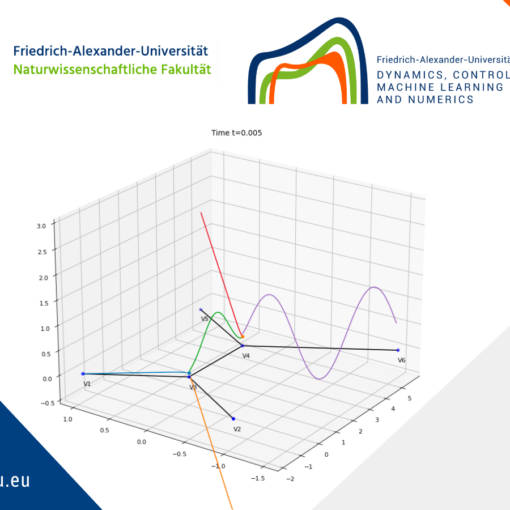Optimal control of Fokker-Planck and transport equations using renormalized solutions
1 Introduction
The fundamental general optimal control problem we consider is the following:
\begin{rcases} \min \limits_{y,u} &\frac{\gamma}{2} \int_{0}^{\mathsf{T}} \int_{\R^d} \bigl(y(t,\mathsf{x})- y_d(t,\mathsf{x})\bigr)^2 + \frac{\gamma_\mathsf{T}}2 \int_{\R^d} \bigl(y(\mathsf{T},\mathsf{x})-y_d(\mathsf{T},\mathsf{x})\bigr)^2 + \frac{\beta}{2} \int _0^\mathsf{T} u(t)^2 \\ \text{s.t.} & \qquad \begin{aligned} \partial_t y + \mathsf{div}((\alpha u) y) - \mathsf{div}(\sigma \sigma^\top \nabla y) &= 0 && \text{in } (0,\mathsf{T}) \times \R^d, \\ y(0) &= y_0 && \text{in } \R^d, \\ 0 \leq u & \leq u_{\max} && \text{in } (0,\mathsf{T}). \end{aligned} \end{rcases} (1.1)
This is a bilinear optimal control problem for a Fokker-Planck equation (1.1) with time-dependent control u \colon (0,\mathsf{T}) \to \R. In the objective function to be minimized, \gamma,\gamma_{\mathsf{T}}\geq 0 with \gamma+\gamma_{\mathsf{T}}>0 are weighting parameters and \beta >0 denotes the control cost.
We control the drift field \alpha u with a given \alpha: \R^d \rightarrow \R^d and a time-dependent control u : (0, \mathsf{T})\rightarrow \R^d, such that the solution y matches a desired state y_d as well as possible in an \mathbf{L}^2-sense, either on the whole time interval (0,\mathsf{T}) considered (first term) or in a finite time \mathsf{T} (second term). We moreover penalize the control u, this can be understood in the sense of control (energy) costs, but also serves analytical regularization purposes, and we also allow for box constraints 0 \leq u \leq u_{\max} to model physical limitations of the underlying process.
The main novelty compared to the existing literature (see [AT20; BKP18; FG17]) is the low regularity in the drift field: We essentially only assume \alpha \in \mathsf{BV}_{loc} \cap \mathbf{L}^{2+\delta} with \delta >0. For Fokker-Planck-equations with this regularity the theory of so called renormalized solutions is used to prove uniqueness of solutions (and thus, in our context, to get a well-defined control-to-state-operator). Analytically this was first done by [Luo12] for the Fokker-Planck-equation, relying on [Amb04] for the transport equation.
2 Renormalized solutions
The concept of renormalized solutions can be understood by considering a linear transport equation, so one of the equations for which the concept was introduced in [DL89]:
\partial_t p + \mathsf{div} (pb) = 0 \quad in (0,\mathsf{T}) \times \R^n, \qquad p(0) = p_0\quad in \R^n \qquad (2.1)
with a drift field b\colon [0,\mathsf{T}]\times \R^n \rightarrow \R^n and a designated solution p\colon [0,\mathsf{T}]\times \R^n \rightarrow \R with initial value p_0 \in \R^n. Such a transport equation with a Lipschitz-continuous drift field is easy to solve by the classical method of characteristics which gives existence and uniqueness of strong solutions. But showing uniqueness of solutions becomes much harder if we consider drift fields b with less regularity, for example such with only Sobolev regularity, where the (weak) derivative is an integrable function, or even of bounded variation where the (distributional) derivative can be identified with a measure.
By smooth approximation of the data, it is not too hard to see that a weak solution in, say, \mathbf{L}^\infty(0,\mathsf{T};\mathbf{L}^\infty(\R^n)) exists. Now, in order to show that this weak solution must be unique, one shows that any weak solution p of (2.1) in \mathbf{L}^\infty(0,\mathsf{T};\mathbf{L}^\infty(\R^n)) is renormalized: For all \beta \in \mathsf{C}^2(\R), there holds in a distributional sense on (0,\mathsf{T}) \times \R^n
\begin{aligned} \partial_t \beta (p) + \mathsf{div}(\beta (p) b) - \bigl(\beta (p)-p \beta ^\prime (p)\bigr) \mathsf{div} (b) = 0. \end{aligned}
This is exactly the equation obtained when multiplying the transport equation(2.1) by \beta'(p) and formally reversing the chain rule. Having the renormalization property at hand, uniqueness follows quite immediately from using \beta(s) = s^2 and a Grönwall argument for drift fields b whose divergence is bounded below (see [Luo12]).
But, especially in later publications, renormalized solutions are not only used to prove uniqueness, but also as a solutions concept in less regular or less integrable situations. The motivation is, that \beta can be used as a cut-off, thus \beta(p) may have better integrability than p and can be used in a weak solution concept.
3 Main results
In our analysis of the Fokker-Planck equation, we begin by distinguishing between two significant cases: the fully parabolic scenario characterized by a positive definite diffusion matrix, and the potentially degenerate case, which does not necessarily hold this assumption (this includes cases where \sigma = 0, leading to a linear transport or continuity equation). In the degenerate case, we can demonstrate the existence of solutions to the aforementioned optimal control problem. In the fully parabolic case, we can also establish optimality criteria.
To proceed, we must first outline several general regularity assumptions:
Assumption 3.1
Lets assume the following:
• \alpha \in \mathbf{L}^2 \cap \mathbf{L}^{2+\delta}(\R^d;\R^d) with a technical growth bound not stated here,
• \sigma \in \mathbf{L}^2(0,\mathsf{T};\mathsf{W}^{1,2}_{loc}(\R^d))^{d \times m} also with a technical growth bound,
• \mathsf{div}(\alpha) \in \mathbf{L}^{1} \cap \mathbf{L}^{1+\delta}(\R^d) with [\mathsf{div}(\alpha)]^- \in \mathbf{L}^\infty(\R^d),
• u \in \mathbf{L}^2(0,\mathsf{T}) and 0 \leq u \leq u_{\max} a.e. in (0,\mathsf{T}) for u_{\max} \in \mathbf{L}^\infty(0,\mathsf{T}),
• y_0 \in \mathbf{L}^1 \cap \mathbf{L}^\infty(\R^d),
• y_d \in \mathbf{L}^2(0, \mathsf{T}; \mathbf{L}^1 \cap \mathbf{L}^2(\R^d)).
3.1 Existence of solutions
To get uniqueness of the associated equation we assume better regularity of the drift field, which means \alpha \in \mathbf{L}_{loc}(\R^d, \R^d) (at least if we are not in the case of a positive definite diffusion, in this case Assumption 3.1 is enough).
Then it is possible to prove existence and uniqueness of the mentioned Fokker-Planck-equation, see [Luo12].
Theorem 3.2.
Lets assume Assumption 3.1 and at least one of the following two:
• \alpha \in \mathbf{L}_{loc}{(\R^d, \R^d)}
• \sigma is uniformly positive definite, which means, that \sigma\sigma^\top \succeq \sigma_\bullet I for some \sigma_\bullet > 0 almost everywhere on [0,\mathsf{T}] \times \R^d.
Then there exists a minimizer of (1.1).
The main challenge in the proof is to derive a suitable stability of solutions to the Fokker-Planck-equation, in the sense, that weak convergence of the control u leads to a sufficiently strong convergence of the solutions y. This is done by an Arzela-Ascoli-type argument, in which consider the dual space of the function space
\begin{aligned} \mathsf{N} = \{f \in \mathsf{H}^1(\R^d) \,|\, \sigma ^\top\nabla f \in \mathbf{L}^2(0, \mathsf{T}; \mathbf{L}^2(\R^d)^m)\ \}. \end{aligned}
Then we are able to prove the mentioned stability in the space \mathsf{C}([0, \mathsf{T}], \mathsf{N}^\prime).
3.2 Optimality criteria
In this section we assume \sigma\sigma^\top \succeq \sigma_\bullet I for some \sigma_\bullet > 0 almost everywhere on [0,\mathsf{T}] \times \R^d. Additionally, we use the control-to-state operator mapping the control u to the unique solution of the Fokker-Planck equation y_u. Next, defining the reduced optimal control problem as usual by setting j: \mathbf{L}^2(0, \mathsf{T}) \rightarrow \R as
\begin{aligned} j(u) = \frac{\gamma}{2} \int_0^{\mathsf{T}} \int_{\R^d} \bigl(y_u- y_d\bigr)^2 + \frac{\gamma_\mathsf{T}}2 \int_{\R^d} \bigl(y_u(\mathsf{T},\mathsf{x})-y_d(\mathsf{T},\mathsf{x})\bigr)^2 + \frac{\beta}{2} \int _0^\mathsf{T} u(t)^2, \end{aligned}
the reduced problem is to minimize j(u) for u \in \mathbf{L}^2(0, \mathsf{T}) subject to 0 \leq u \leq u_{\mathrm{max}}. Then we are interested in the gradient of j and get the following theorem:
Theorem 3.3
In the case \gamma >0 the gradient of j is given by
\begin{aligned} \nabla j(\bar u) = \gamma \int_{\R^d} y_{\bar u}(\alpha , \nabla q) + \beta \bar u \end{aligned}
with q being the adjoint state from
\left.\begin{aligned} -\partial_t q(t) - \bigl( u \alpha, \nabla q(t)\bigr) - \mathsf{div}e(\sigma(t)\sigma(t)^\top \nabla q(t)) & = f(t) && \text{in } (0,\mathsf{T}) \times \R^d, \\ q(\mathsf{T}) & = q_\mathsf{T} && \text{on } \R^d, \end{aligned} \right\} \quad (3.1)
with q_{\mathsf{T}} = \frac{\gamma \mathsf{T}}{\gamma}\left(y_{\overline{u}}(\mathsf{T})- y_d(\mathsf{T})\right) and f := y_{\overline{u}} - y_d.
The main challenge in the proof of this theorem is a suitable continuity property of the solution operator (which is Hölder-continuity) and the proof of a duality formula. In the proof of the duality formula it is necessary to use renormalized solutions to handle the bad integrability of several terms arising in the natural proof of the duality formula.
4 Further research
It would be interesting to generalize the existence result to the case of controlling the full drift field instead of controlling only the time dependency u. But for the underlying stability result that seems to be necessary, there is a counterexample in [LGS16], Section 4, see also [Sei1], Example 1.
At the moment we generalize the above results to a bounded domain. Therefore it is necessary to find a meaningful framework in the definition of the boundary conditions working well with theory of renormalized solutions.
References
[Amb04] L. Ambrosio (2004) Transport equation and Cauchy problem for BV vector fields, Inventiones mathematicae, Vol. 158 No. 2, pp. 227–260, doi: 10.1007/s00222-004-0367-2[AT20] M.S. Aronna, F. Troeltzsch (2020) First and Second Order Optimality Conditions for the Control of Fokker-Planck Equations, ESAIM:COCV
[BKP18] T. Breiten, K. Kunisch, and L. Pfeiffer. Control strategies for the Fokker Planck equation. ESAIM: COCV, Vol. 24, No.2, pp. 741–763
[DL89] R.J. DiPerna, P.L. Lions. Ordinary differential equations, transport theory and Sobolev spaces (1989), Inventiones Mathematicae, No. 98, Vol. 3, pp. 511–547, doi: 10.1007/bf01393835
[FG17] A. Fleig, R. Guglielmi (2017) Optimal Control of the Fokker-Planck Equation with Space-Dependent Controls, Journal of Optimization Theory and Applications, Vol. 174, doi: 10.1007/s10957-017-1120-5
[LGS16] C.D. Lellis, P. Gwiazda, A. Swierczewska-Gwiazda (2016) Transport equations with integral terms: existence, uniqueness and stability, Calculus of Variations and Partial Differential Equations, Vol. 55, pp. 1–17
[Luo12] D. J. Luo (2012) Fokker-Planck type equations with Sobolev diffusion coefficients and BV drift coefficients, Acta Mathematica Sinica, English Series, Vol. 29, No. 2, pp. 303–314, doi: 10.1007/s10114-012-1302-x
[Sei16] C. Seis (2016) Optimal stability estimates for continuity equations, Proceedings of the Royal Society of Edinburgh: Section A Mathematics, Vol. 148, pp. 1279–1296.
|| Go to the Math & Research main page


 Christian Lange
Christian Lange







